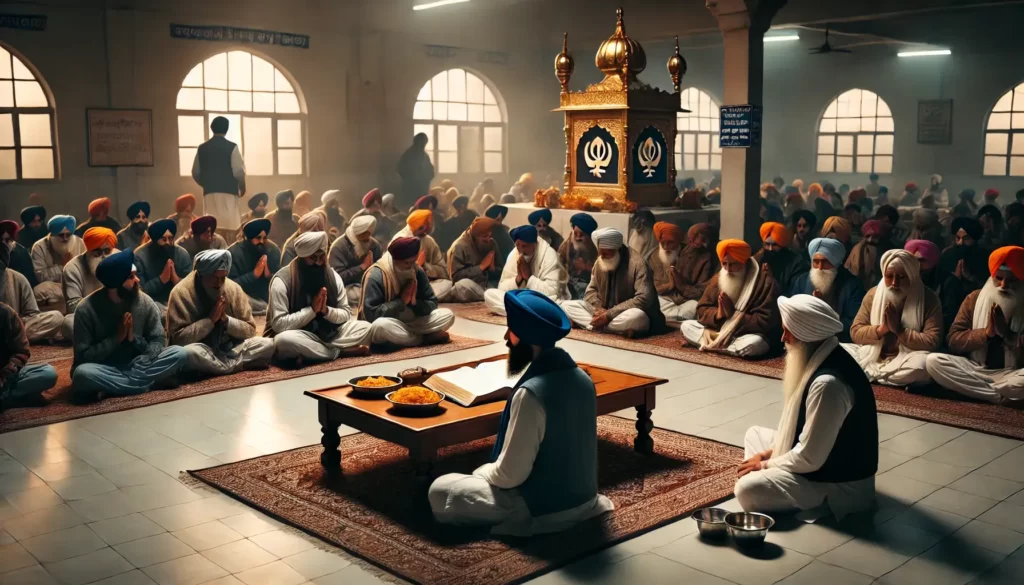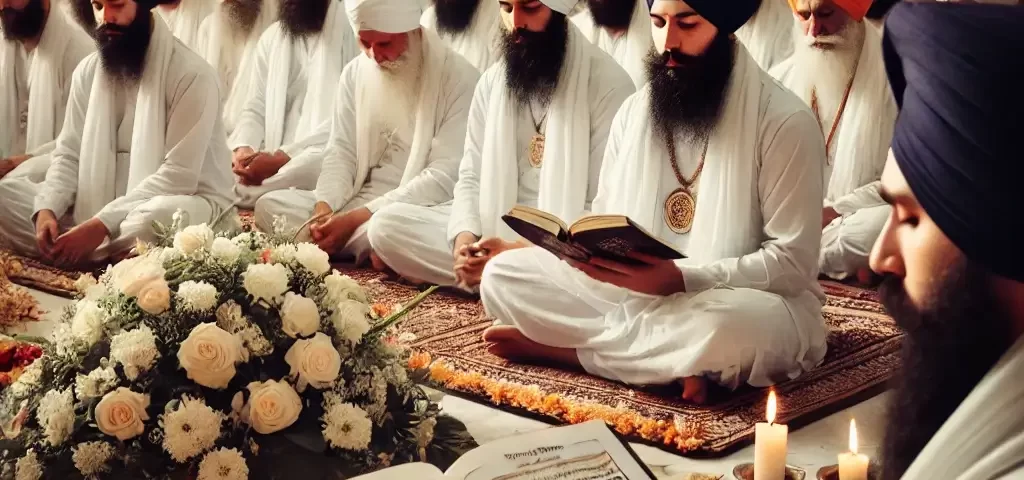Sikh Funeral Ceremonies

Zoroastrian Funeral Traditions
March 11, 2025
Jewish Funeral Practices
March 11, 2025Sikh death rituals, or Antam Sanskar, emphasize spiritual freedom from life not grief. Death, in this context, is merely a journey of the soul returning to Waheguru (the Divine). The rites emphasize prayer, family support, and remembering the person over lamenting despair. Sikhs do recognize the birth, death, and reincarnation cycle but also ultimately seek liberation (mukti) through devotion and works of piety.
The Importance of Funerals in Sikhism
Funerals are of deep importance in Sikhism because they allow for honoring the deceased and reaffirming belief in divine will (hukam). The community comes together to show support, read prayers, and perform acts of service (seva). While many traditions are based on extensive mourning, Sikh funeral practices call for acceptance and remembrance by means of prayer and good deeds.
Sikh beliefs, founded on the Guru Granth Sahib, describe death as a natural stage of life. The soul, guided by karma and devotional love to Waheguru, moves towards liberation. Sikhs do not believe in heaven and hell as eternal residences but in spiritual growth determined by attachment to divinity. Attachment of love to the body is not favored, and cremation is utilized to symbolize returning the body to nature and the soul moving on.
Overview of Sikh Funeral Practices
Sikh funeral rituals are a systematic but straightforward process based on reverence and piety. Antam Sanskar involves the reading of hymns, group prayers, and a cremation ceremony. The family and community meet at the Gurdwara or cremation ground, where readings from the Guru Granth Sahib are done to give spiritual solace. Following cremation, ashes are usually dipped in a river, symbolizing return to nature.
Key Elements of a Sikh Funeral
Antam Sanskar – The Final Rites
Meaning and Significance of “Antam Sanskar”
Antam Sanskar means “final rites” and is the Sikh reaction to death with acceptance and dignity. The ceremony is to pray for the peace of the deceased soul while reminding the mourners to be devoted to Waheguru.
Role of Prayers and Spiritual Readings
Prayers play a significant role, and Ardas (supplication) and hymns from the Guru Granth Sahib are recited. Sukhmani Sahib and Anand Sahib are recited regularly to bring about peace and reflection. The focus is on remembering the departed through devotion and spiritual service.
Sikh Funeral Process
Body Preparation and Washing Rituals
The body is washed and dressed in plain clothing, usually with a turban for males. Relatives and elderly members of the community are involved in these ceremonies, providing respect and dignity to the deceased.
The Role of Family and the Sikh Community
Sikh funerals are collaborative, with friends and family coming together to provide prayers and support. Performances of seva (selfless service), for example, food preparation for the congregation, uphold humility and unity.
Cremation in Sikhism
Why Cremation is Preferred Over Burial
Cremation aligns with Sikh beliefs about impermanence and detachment from the physical form. Fire is seen as a purifier, and returning to nature reflects the cycle of existence.
The Significance of Returning to Nature
Following cremation, ashes are generally submerged in a river to mark the last journey back into the elements. The ritual itself is an acknowledgment that the flesh is mortal but that the spirit will go on in its onward path.
Ardas (Funeral Prayer) & Kirtan Sohila
Reciting Hymns from the Guru Granth Sahib
During the funeral, hymns such as Kirtan Sohila (nighttime prayer) are sung to provide solace. These verses emphasize devotion, acceptance of divine will, and the transient nature of life.
Importance of Collective Prayer
Prayers unite the community and reinforce Sikh values of equality and humility. Everyone is encouraged to join in remembrance and offer blessings for the soul’s journey beyond this life.
Bhog Ceremony & Langar
The Conclusion of Funeral Rites
A Bhog ceremony seals the funeral rituals. A last reading of the Guru Granth Sahib or Akhand Path (consecutive reading of holy texts) is arranged by the family as a last respect for the departed soul.
The Communal Meal to Honor the Deceased
A Langar (communal meal) is then held after the funeral, with the theme of oneness and service. The gathering provides the family with emotional support and reaffirms the Sikh ethic of feeding all humanity, irrespective of background or creed.

Sikh Mourning Traditions
Duration of Mourning in Sikhism
Sikh mourning customs emphasize acceptance, not extended mourning. Mourning periods are short, as Sikhs feel extended sorrow can inhibit spiritual advancement. Families instead sit together to recite scriptures and do seva in remembrance of the departed. Although there may be some families that keep quiet for a few days, life is meant to resume its normal pace as quickly as possible.
How Sikhs Express Grief While Focusing on Spirituality
Grief is balanced with piety. Rather than dwelling on death, Sikhs channel their grief into prayer and service. Families may sponsor recitals of Akhand Path or contribute to charity to bring merit to the soul of the deceased. Commemorating the dead through selfless service is in keeping with Sikh teachings on compassion and humility.
Memorial Services and Annual Remembrances
It is common for Sikh communities to organize an annual remembrance service for their loved ones. Barsi is a death anniversary where collective prayers and hymn recitations help families honor their loved one while strengthening one’s faith. Acts of charity, such as feeding the needy or donating to the Gurdwara, can become a long-term commemoration in Sikhism.
Etiquette & Behavior at a Sikh Funeral
What to Wear to a Sikh Funeral
Modest and conservative dressing is necessary. Women and men must dress in loose clothes that cover the arms and legs. White or light-colored clothes are traditionally used since they represent peace and purity. Head covering like a scarf or turban must be worn while going to the Gurdwara or taking part in prayer.
How to Show Respect in the Gurdwara
Upon entering a Gurdwara, shoe removal and head covering are signs of respect. Guests should remain silent, listen to the prayers, and participate in the hymns if at ease. Bowing in front of the Guru Granth Sahib is practiced but not obligatory for non-Sikhs. Being silent and having a respectful attitude is most important.
What Non-Sikhs Should Know When Attending
Other religions are welcome to visit Sikh funerals and are expected to observe general practice. Attendance during prayer is not required, but silent presence is appreciated. Flowers are not customary, but donations or visits to Langar are a more acceptable display of respect. Prayer, communal support, and remembering the deceased through acts of charity remain the center of attention.
Modern Sikh Funerals & Adaptations
Eco-Friendly Cremations and Digital Memorials
With rising environmental issues, a large number of Sikh families are opting for green funeral practices. Eco-friendly urns and natural cremation processes minimize the effect on the environment while reflecting Sikh principles of being in harmony with nature. A few communities have embraced online memorials where family members can join in prayers and ceremonies remotely. Websites also offer a platform for loved ones to share memories and offer tribute.
Sikh Funeral Customs in Western Countries
Sikh funeral practices have evolved to reflect life in Western nations. Many Sikh communities will now conduct a service in the funeral home and then go to a Gurdwara or cremation area. Some will include other legal and administrative phases necessary in majority non-Sikh nations while not altering the essentials of Antam Sanskar spirituality. Virtual visitation has become more prevalent so that family members who are otherwise located can also be included in final rites.
Conclusion
Sikh death rites present a poignant method to memorialize the dead and uphold faith in the divine will. In prayer, unselfish service, and collective aid, Sikh rituals emphasize freedom from worldly bonds over grieving. From formal rites to contemporary versions, remembering the deceased in respect and reverence remains paramount. In this practice, Sikhs maintain the tradition that the legacy of their beloved is continued in deeds of goodness and belief.


